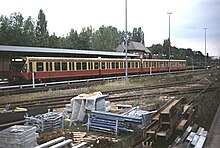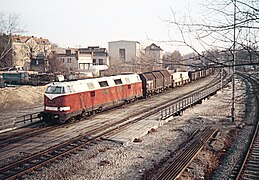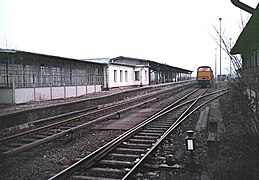Berlin-Tegel train station
| Berlin Tegel | |
|---|---|
|
Platform of the Tegel train station
|
|
| Data | |
| Operating point type | railway station |
| Location in the network | Intermediate station |
| Design | Through station |
| Platform tracks | 2 |
| abbreviation | BTG |
| IBNR | 8089089 |
| Price range | 5 |
| opening |
October 1, 1893 May 28, 1995 |
| Conveyance | January 9, 1984 |
| Website URL | s-bahn-berlin.de |
| Profile on Bahnhof.de | Berlin Tegel |
| Architectural data | |
| architect | Karl Cornelius |
| location | |
| City / municipality | Berlin |
| Place / district | Tegel |
| country | Berlin |
| Country | Germany |
| Coordinates | 52 ° 35 '19 " N , 13 ° 17' 22" E |
| Railway lines | |
|
|
| Railway stations in Berlin | |
The Berlin-Tegel station is a station of the Berlin S-Bahn in the Reinickendorf district . It is currently served by the S25 line.
location
The station is on the 10.9 kilometer of the Kremmener Bahn , at ground level and immediately south of the Gorkistraße level crossing. It has two exits on both sides of the railway line. The main entrance is on Buddestrasse, near the junction of Grußdorffstrasse. There is a bus stop on the station forecourt (Buddeplatz), which is served by lines 133 and N25 of the Berliner Verkehrsbetriebe (BVG). The next entrance to the Alt-Tegel underground station is around 400 meters away at the junction of Grußdorffstraße and Berliner Straße.
history
Early years
During the time of the German Empire , Prussia opened the Kremmener Bahn ( Schönholz - Tegel - Hennigsdorf - Velten - Kremmen ) in 1893 to develop the municipalities of the Havelland northwest of Berlin. With the line initially designed as a single-track branch line, Tegel station was opened to traffic on October 1, 1893. The trains first drove from Stettiner Bahnhof (from 1950: Nordbahnhof ) over the tracks of the Nordbahn to Schönholz, where they branched off onto the Kremmener Bahn and went via Tegel to Velten. On December 20, 1893, the line was extended to Kremmen.
After the founding of the Borsigwerke in Tegel (1898), the line gained importance for freight traffic. Therefore, the route to Tegel station was expanded to two tracks and opened on October 1, 1905. In the course of this, the Tegel station was expanded to include a freight yard . In 1910, the AEG plants were opened in Hennigsdorf , whereupon the Kremmener Bahn from Schönholz to Velten was upgraded to the main line . The dense traffic of local passenger , long-distance and freight trains forced a double-track expansion to Velten in the years 1921–1927. Shortly after the Tegel train station, a connection was established in 1922 with the Tegel – Friedrichsfelde industrial railway , which opened in 1908 and which, coming from the Friedrichsfelde freight yard , connected the Tegeler Hafen with numerous industrial companies in the north-east of Berlin.
Pre-war period
The electric train traffic with side 800 V - busbar ( DC ) was taken on 16 March 1927th The trains ran every ten minutes during rush hour; 16,000 travelers used the route in each direction. Up to 5,000 day trippers used the route on weekends, especially as far as Tegel. Until 1939, the Kremmener Bahn was the most frequented suburban railway in Berlin alongside the Wannsee Railway .
World War II and post-war period
In the era of National Socialism at the station Tegel one was forced laborers camp set up, the supply of the nearby Borsigwerke with forced labor (especially from the Netherlands served).
After the Second World War , the city's S-Bahn network was in ruins. Only a third of all trains, railway systems and station buildings were still functional after the war. In addition, as one of the last acts before the capitulation, the National Socialists had blown up the north-south tunnel in the area of the Landwehr Canal and thus flooded the entire length, including the underground Stettiner S-Bahn station , from which the trains in the direction of Tegel left. Therefore, in 1945 and 1946 - since the power grid had also collapsed - improvised steam-powered S-Bahn trips from the Szczecin (long-distance) train station to Tegel were carried out. As a reparation payment , the second track between Schönholz and Velten was dismantled in 1945 and shipped to the Soviet Union . So the Kremmener Bahn became a single-track branch line again .
On November 16, 1947, the north-south tunnel with the section from Friedrichstrasse to Szczecin station was completely drained and put into operation. This closed the last gap and the pre-war S-Bahn system was largely restored and electrified, even if in some places still improvised and in shuttle service.
French military station during the occupation
Located in the French sector of the four- sector city of Berlin, Tegel station was used for French military transports soon after the war. It was opened on December 6, 1947 by the French city commander Jean Ganeval . For the loading of goods and soldiers, an area of the Tegel freight station was seized by the French army, who renamed it Gare Française Berlin-Tegel . The track between the station building and Buddestrasse was used for passenger traffic. The first military train ran on 18/19. November 1945 between Baden-Baden and Berlin-Wannsee . From 12./13. November 1946, the French military train operated three times a week as DFA 651 from Mainz to Berlin-Tegel and as DFA 652 in the opposite direction. The direct traffic connection from Tegel to French train stations were generally referred to as "French trains". The headquarters of the French armed forces as Quartier Napoléon was laid out in the former Hermann Göring barracks . There was a siding to the Flohr-Otis company from Tegel station . By extending it, a track connection to the Kurt-Schumacher-Damm and these barracks was established for better transport of military equipment such as tanks . During the Berlin blockade after the collapse of the winning coalition, operations were suspended for 13 months. From April 21, 1948, all service trains to and from Berlin were canceled. The blockade began on June 24, 1948 and ended on May 12, 1949. The trains were reserved exclusively for members of the French Armed Forces (FFA) and their families and were used free of charge. Often these trains also carried freight wagons and they were used for freight traffic. In the event of death, members of the military were transferred in the abandoned refrigerator truck. In the 1980s the service trains ran on the network of the Deutsche Reichsbahn as "DB 1040/1041 b" (b for occupying power), on the network of the Deutsche Bundesbahn as Dm 38040/38041. The French military trains ran from Tegel via Berlin until 1994 Ring railway to Strasbourg to bring French soldiers home.
The last military train to Strasbourg ran on August 30, 1994, and the Gare Francaise station was closed at the same time . The building was used by the North Berlin antique, art and collector's market until 2004. From March 2006 a nursing home for the elderly was built on 12,000 m² of the freight yard. The station building was bought and renovated by the home operator of domino-world. The building is listed as a monument. The facility can be used for events without any permanent fixtures being attached inside. The exterior view must also be preserved.
Division of Berlin
When the Wall was built on August 13, 1961, the Kremmener Bahn was also divided. The terminus of the West Berlin S-Bahn traffic was Heiligensee , all long-distance trains in the GDR area ended in Velten. The boycott of the S-Bahn operated by the Deutsche Reichsbahn in West Berlin and the second Reichsbahn strike in 1980 caused considerable damage to the S-Bahn traffic in the western part of the city. However, the Kremmener Bahn to Heiligensee remained in operation. With the transfer of the S-Bahn operating rights in West Berlin to the BVG on January 9, 1984, the Schönholz - Tegel - Heiligensee line and with it Tegel station were closed for S-Bahn traffic. All that remained was the goods traffic to the industrial companies located in the former Borsigwerke, the "French trains" and the coal trains for the Märkisches Viertel thermal power station, which ran two to three times a week and used the route of the former Tegel – Friedrichsfelde industrial line.
V 180 at the entrance to the temporary bridge over the motorway construction site, 1986
Werklok TGM23B of Thyssen Stahl AG tape (ehem. Borsig locomotive 9) and parked passenger coaches of the French armed forces
After reunification

After German reunification , the Berlin House of Representatives decided in 1991 to largely restore the S-Bahn network from 1961. In the course of this, the renovation of the Kremmener Bahn, i.e. the re-establishment of the S-Bahn traffic from Schönholz to Hennigsdorf, was decided. The renovation should take place in two steps. On May 28, 1995, following the renovation of the Gorkistraße level crossing and some bridge structures, the Schönholz - Tegel line was reopened. After a 37-year break, the first S-Bahn train was accepted again at Hennigsdorf station on December 15, 1998. The new line, called the S25, was directed from Lichterfelde Süd through the north-south tunnel onto the Kremmener Bahn and continues via Tegel to Hennigsdorf. In 2005 the route in the south was extended to Teltow Stadt . An extension in the north to the old terminus in Velten is under discussion.
In the course of the renovation of the line, the Tegel station was restored to two tracks. The route as such remained single-track, which means that a maximum of 20-minute intervals in S-Bahn traffic is still possible. The half-timbered building of the former Tegel freight yard has been preserved; flea markets and similar events take place here. In addition, two signal boxes have been preserved, but they are no longer of any practical use. With the exception of the two S-Bahn tracks, the area in front of the train station , which is relatively large for a local transport station , is idle , since the line was of no importance for goods traffic and also for passenger traffic outside the S-Bahn when the industrial line Tegel - Friedrichsfelde was closed in 1997 at the latest has lost.
From mid-2006 to mid-2007, a new nursing home was built on part of the former track system southwest of the S-Bahn platform. The unused track systems in this area were cleared beforehand.
On August 21, 2012 at 11:42 a.m., two wagons of an S-Bahn derailed immediately behind the station after the exit in the direction of Hennigsdorf , when a flank protection switch under the moving train was switched over as a result of a route that had been broken up too early by the dispatcher . Six people were slightly injured.
The control computer building for an electronic signal box will be built in Tegel station by autumn 2021 . This will control the section Berlin-Schönholz (exclusively) to Hennigsdorf and replace the relay signal boxes in Reinickendorf, Tegel and Heiligensee. At the same time, the sidings south of the S-Bahn platform will also be rebuilt and extended.
future
In the next few years, a thorough renovation of the section between Schönholz and Tegel will be necessary. In this context, the reconstruction of the second S-Bahn track and the introduction of a 10-minute cycle to Tegel are planned. The states of Berlin and Brandenburg are also investigating the integration of the Prignitz Express via the Kremmener Bahn to Gesundbrunnen station . The preferred variant provides for the construction of a third long-distance railway track between Schönholz and Tegel for regional and freight traffic, based on the basic renovation and creation of the two-track system in Berlin. In Tegel station, the Prignitz Express will stop at a new regional platform that is to be built.
Connection
The S-Bahn station is served by the S25 line of the Berlin S-Bahn. There is a possibility to change to the bus lines of the Berliner Verkehrsbetriebe .
Web links
- Entry in the Berlin State Monument List
- Photos of the French trains in Tegel station
- Tegel station at stadtschnellbahn-berlin.de
- History of the Kremmener Bahn
- The Gare Française Berlin-Tegel on kremmener-bahn.net
Individual evidence
- ↑ Station price list 2020. In: Deutsche Bahn. Deutsche Bahn, January 1, 2020, accessed on July 11, 2020 .
- ↑ 110 years of Kremmener Bahn ( memento of the original dated February 7, 2007 in the Internet Archive ) Info: The archive link was automatically inserted and not yet checked. Please check the original and archive link according to the instructions and then remove this notice. from the Bürgerpost Oberkrämer , No. 3, October 2003
- ^ History of the Kremmener Bahn
- ↑ Network map of the S-Bahn Berlin 1945
- ↑ http://www.stadtschnellbahn-berlin.de/strecken/03/chronik.html Chronicle of the north-south S-Bahn tunnel
- ↑ a b c The Gare Francaise briefly introduced
- ↑ Allied monuments : “At the beginning of the occupation, the French armed forces did not have their own train station and used that of the Americans in Wannsee. [...] France was the only allied protective power in West Berlin with a direct rail connection to the mother country, so that military trains to and from Tegel were not only used for the transport of supplies and men, but until September 1994 also for the families of the military and French exchange students could be used. The French military train (TMFB - train militaire français de Berlin) traveled three times a week from Tegel to Strasbourg. In its heyday it carried up to 100,000 passengers a year. "
- ↑ Lexicon from www.stadtschnellbahn-berlin.de : "Franzosenzug"
- ↑ A track remainder of this extension crosses the Seidelstrasse ( location ) at the edge of the JVA Tegel at Seidelstrasse 44. To the north still as a route in the KGA Am Waldessaum towards Flohrstrasse.
- ↑ as well as by employees of French institutions such as the French grammar school
- ↑ Buddestraße: Terminal building of the French military station Berlin-Tegel (formerly)
- ↑ Network plans of the Berlin S-Bahn: compare the division: 1952 , 1961 before the Wall was built , network plan of the S-Bahn Berlin 1966
- ↑ "Domino-world" now also in Tegel. (PDF) In: Oranienburger Generalanzeiger . June 27, 2007, accessed December 25, 2013 .
- ↑ Investigation Report - Train derailment, 21.08.2012, Berlin-Tegel. (PDF) (No longer available online.) Federal Railway Office , December 2, 2013, archived from the original on December 27, 2013 ; Retrieved December 25, 2013 . Info: The archive link was inserted automatically and has not yet been checked. Please check the original and archive link according to the instructions and then remove this notice.
- ^ Reports from the Berlin S-Bahn . In: Bahn-Report . No. 3 , 2020, p. 36 .
- ↑ Feasibility study for the integration of the Prignitz-Express via the Kremmener Bahn to Berlin-Gesundbrunnen. Ministry of Infrastructure and Agriculture of the State of Brandenburg, March 19, 2012, accessed on March 20, 2012 .






